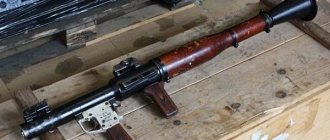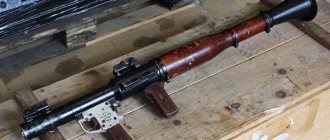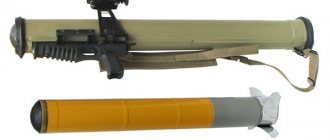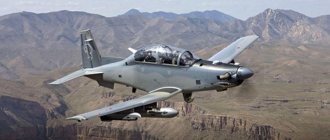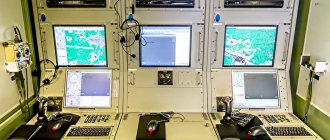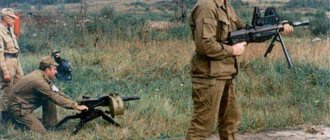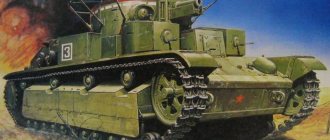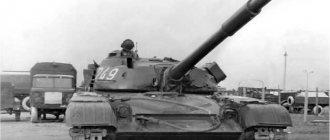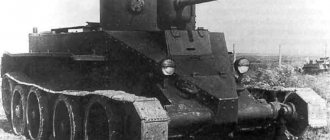The GP-30 “Obuvka” under-barrel grenade launcher is distinguished by its exceptional simplicity and convenience, high efficiency and decent performance characteristics. Working with it does not require long-term skill development for fighters, which is also a significant advantage of the product. However, since when did this grenade launcher appear in service, is it used now, does it have any modifications? Answers to these and many other questions will be provided within the framework of this article. GP-30 has been produced since 1989, its production continues today. It was developed in the USSR, focusing on the results of the war in Afghanistan and the practical aspects of using under-barrel grenade launchers in combat conditions. According to GRAU, the product bears the index 6G21. Created as part of a joint project entrusted to TsKIB SOO and State Research and Production Enterprise “Pribor”, based on the GP-25 “Koster”, taking into account the strengths and weaknesses of this solution. The work was supervised by designer Valery Nikolaevich Telesh V.N (creator of the Penal, Penal, RG-6 grenade launchers). The first steps in the design of the GP-30 were taken in 1985, and already in 1989 the new grenade launcher was put into service. Production is carried out at the Tula plant.
Armament
Combat properties, general structure, purpose of main parts and mechanisms, order of partial disassembly. The design of the shots used.
Purpose
The GP-25 under-barrel grenade launcher is an individual weapon and is designed to destroy open manpower, as well as manpower located in open trenches, trenches and on reverse slopes. The grenade launcher is used in conjunction with a Kalashnikov assault rifle.
Combat properties:
- caliber, mm - 40
- number of grooves - 12
- sighting range, m: maximum – 400 min. with hanging trajectory — 200
- effective firing range, m fragmentation grenades - up to 250 irritant grenade - up to 200
- combat rate of fire, r/min. — 4-5
- weight of the grenade launcher without butt plate, kg - 1.5
- portable ammunition, rds. - 10
- initial grenade flight speed, m/sec - 76
- fuse arming range, m - 10-40
- grenade self-destruction time, sec - not less than 14
- rupture height (on medium-hard soil) VOG-25p, m - 0.75
- shot weight VOG-25, VOG-25p, kg - 0.225
- weight of the “Nail” shot, kg - 0.170
- Type of shots used: VOG-25 (with a fragmentation grenade) VOG-25p (with a bouncing fragmentation grenade) VOG-25in (shot with inert ammunition) “Nail” (shot with an irritant gas grenade)
- Radius of dispersion of lethal fragments, m - up to 7
General device
The GP-25 is mounted under the barrel of the machine gun. It consists of 3 main parts:
- barrel with sighting device and bracket for attaching to a machine gun
- breech
- trigger housing with handle
The grenade launcher kit includes:
- butt plate with belt
- return spring guide rod with latch
- grenade launcher bag
- shot bag
- banner
- cleaning rod (cleaning device)
With the GP-25 attached, the machine gunner, depending on the task at hand, can fire from both a grenade launcher and a machine gun. Firing is carried out by direct and indirect fire (flat and mounted trajectory). To alleviate the recoil force, which when firing from a grenade launcher is slightly greater than when firing from a machine gun, a special rubber butt pad is installed on the butt of the machine gun.
Purpose of the main parts and mechanisms of the grenade launcher
Trunk
The grenade launcher serves to direct the flight of the grenade, has 12 rifling, curling from left to top to right, serving to give the grenade a rotational movement during flight, which ensures its stability along the trajectory.
bracket
designed for attaching a grenade launcher to a machine gun and placing sighting devices. The front and rear supports of the bracket have seats for mounting a grenade launcher on a machine gun.
Aim
serves to aim the weapon at the target when firing from a grenade launcher.
There is a distance scale on the bracket on the left under the sight. Distance scale:
the first group of numbers (white) from 1 to 4 is intended for installing sights when shooting direct fire (flat trajectory).
Intermediate divisions correspond to firing ranges of 150, 250 and 350 m. The second group of numbers (red) is intended for semi-direct fire (overhead trajectory). When firing directly
(for shooting with a flat or mounted trajectory), aiming is carried out using one guide aiming line passing through the middle of the rear sight slot, the top of the front sight to the aiming point.
When aiming semi-directly
(for shooting with a mounted trajectory), aiming is carried out separately: - in the horizontal plane, aiming is carried out at the front sight so that it is in line with the target - in the vertical plane along a plumb line - the machine gun is given such an angle so that the mark on the plumb line coincides with the mark ( 11) on the stopper bushing
The plumb line serves to give the grenade launcher the necessary elevation angles when firing with indirect fire (overhead trajectory) at unobserved targets located on reverse slopes, terrain folds or in open trenches and trenches. It is installed on the sight axis using a plumb bob bushing and a stopper bushing. The sight spring presses the plumb bob bushing against the closing protrusions of the sight axis and thus secures the sight in assembled form. The sight stopper ensures that the sight cannot be reset at the moment of firing; the stopper spring holds it in the upper position.
Breech:
is a high-pressure chamber in which the grenade propellant charge is burned.
Trigger housing with handle
connects to the breech and together with it represents a part of the grenade launcher, separated from the barrel with a bracket when the grenade launcher is placed in a carrying bag. The housing houses the trigger mechanism.
Lever
serves to hold the grenade launcher when firing; it is connected to the body by means of an elastic lock.
Frame
The housing covers the forend of the machine gun and protects it from mechanical damage when firing. An elastic insert is glued into the body frame, which serves to prevent hard impacts on the receiver of the machine gun when firing from a grenade launcher.
Shock trigger mechanism
serves to fire a shot from a grenade launcher. It consists of:
- trigger with striker
- release with spring and rod
- pusher
- mainspring
- oppression
Translator
when set to the “PR” position (the lever is in a vertical position), it locks the trigger, protecting the loaded grenade launcher from an accidental shot. Before firing a shot, the translator put the lever in the horizontal position in the “OG” position), thereby releasing the trigger.
Butt pad
serves to soften the recoil force when firing from a grenade launcher when the butt of the machine gun is resting on the shoulder of the shooter and to prevent deformation of the butt of the machine gun when firing with the butt resting on hard ground.
The procedure for partial disassembly and assembly of a grenade launcher
Disassembly of a grenade launcher can be incomplete or complete. Partial disassembly is performed during routine maintenance. Complete disassembly is carried out during maintenance, for cleaning in case of severe contamination, after the grenade launcher is exposed to rain or snow, and during repairs.
The grenade launcher is disassembled and assembled on a table or clean mat (tarpaulin). Place parts and mechanisms in the order of disassembly, handle them carefully, do not place one part on top of another, do not allow them to hit hard objects or each other, and do not use excessive force during disassembly and assembly. The procedure for incomplete disassembly of a grenade launcher:
Reassembly after partial disassembly is carried out in the reverse order:
- attach the breech to the trigger body
- insert the housing axis and translator into their holes
- attach a check
- attach the barrel to the trigger body
- put the translator in the “PR” position
Technical characteristics of the 40-mm under-barrel grenade launcher GP-30 Obuvka, index 6G21.
Caliber, mm 40 Length of the rifled part of the bore, mm 100 Number of rifling 12 Weight of the grenade launcher (without guide return spring, butt plate with belt and ramrod clamp), kg 1.53 Length of the aiming line, mm 90 Overall dimensions, mm, no more (length , width, height): in combat position: 280x68x192 in stowed position: 280x68x130 Sighting range, m: minimum: 100 maximum: 400 Rate of fire, rounds/min 5 - 6 Carryable ammunition, rounds 10 Initial grenade flight speed, m/s 76
Soar with Bonfires, GP-25 in military service
The issue of fire support for infantry units on the battlefield has been and is facing any army in the world. The problem of large and small caliber, ammunition efficiency and maximum destructive power is a priority for all military personnel and designers.
In the offensive, as well as in the defensive, it was not always possible to provide effective support with anything more serious than personal small arms. For these purposes, in the 1970s, the USSR began developing a new type of weapon for the country - the GP-25 under-barrel grenade launcher, which received the name “Koster”.
Maintenance of the GP-30 grenade launcher Shoes.
3.1 General instructions. 3.2 Types of maintenance and frequency. 3.3 List of work carried out during various types of maintenance. 3.4 Disassembling and assembling the grenade launcher. 3.4.1 General instructions. 3.4.2 Incomplete disassembly. 3.4.3 Assembly after partial disassembly. 3.4.4 Complete disassembly. 3.4.5 Reassembly after complete disassembly.
3.5 Checking the grenade launcher combat and bringing it to normal combat. 3.6 Cleaning and lubrication. 3.6.1 General provisions. 3.6.2 Materials used for cleaning and lubrication. 3.6.3 Cleaning and lubrication procedure. 3.7 Preservation and re-preservation.
4 Current repairs. 5 Storage rules. 6 Transportation of grenade launchers and shots. 7 Disposal of the grenade launcher. Appendix A Illustrations.
History of the Koster underbarrel grenade launcher
With the invention of grenades, the question arose about simple and effective delivery of them to the enemy. Hand-held mortars and bombards were ineffective due to heavy recoil or were difficult to use due to the weight and size of the ammunition.
The First World War gave new life to this type of weapon. Positional warfare required new types of weapons capable of firing a powerful charge along an overhead and straight trajectory.
Muzzle grenade launchers developed at the beginning of the 20th century had many disadvantages. The attached tromblon shot did not make it possible to quickly switch to fire with conventional ammunition, and an accidental shot with the wrong type of cartridge could lead to sad consequences for the shooter.
The samples used did not have good enough characteristics to make a serious contribution to the picture of the battle or occupy a worthy niche in the armament of the countries participating in World War II.
Only in the post-war period was the idea of small rifle grenade launchers addressed again, using new technical ideas.
During the Vietnam War, the American army successfully tested a sample of the M203 under-barrel grenade launcher. This weapon, attached to an assault rifle, was a full-fledged automatic grenade launcher system, not ideal, but which contributed to the successful actions of the military.
Soviet intelligence immediately learned about the developments of the potential enemy, and the engineers were tasked with developing weapons of the same class. KB Iskra completed the task by 1978. In the same year it was adopted into service.
However, mass production was launched only in 1980, with the outbreak of hostilities in Afghanistan and the birth of new tactics of combat operations in the mountains. Tula gunsmiths took up production. The model was adjusted for all types of AK assault rifles used by the Soviet army.
Subsequently, taking into account the experience of the war, the Koster was upgraded to the GP-30 Obuvka. The already simple design was lightened and simplified.
Reasons for the development of GP-30, predecessors and modifications
Today, the GP-30 “Obuvka” is represented by modifications of the GP-30U “Granat” and GP-30M. The GP-30U modification is an export version of the grenade launcher for mounting on foreign-made machine guns and rifles. The predecessors of these solutions were the GP-25 Koster grenade launcher system, which was actively used in the Afghan war, exhibiting a number of shortcomings during operation. Accordingly, it was decided to improve the complex, achieving maximum efficiency in its use, as well as reducing production costs. The work was carried out actively, since a huge list of nuances characteristic of the Afghan war made the use of grenade launchers necessary. The shortcomings of the GP-25 required elimination; they clearly manifested themselves against the backdrop of active hostilities. Among the main problems noted in practice was excessive weight - it needed to be reduced. There was also a need to simplify and reduce the cost of the production process. In carrying out this work, the specialists abandoned the plumb line, simplifying the sight and moving it to the right side, and in addition, got rid of the clamping rings. The right sight simplified the aiming process itself; the shooter only had to tilt his head towards the butt, which added operational advantages to the product, and also simplified the process of training soldiers and increased the efficiency of using the weapon. Moving the sight also simplified the landing process, during which it is necessary to bring the machine gun with the grenade launcher into the “on the belt” position. In practice, the new sight also turned out to be convenient when crawling, as it was less susceptible to blockages and impacts.
Design features of GP-25
The Soviet model, in contrast to the American under-barrel grenade launcher, is distinguished by its simplicity of design. This is a single-shot model, muzzle-loading type. Barrel with 12 right-hand rifling, 40 mm caliber. The entire device is assembled from 3 parts, plus 2 additional parts. This:
- breech;
- barrel with mount and sight;
- trigger mechanism;
- rubber gasket for butt;
- weapon care tool.
Additionally, the kit included a reinforced AK return mechanism, since the standard AKM/AK-74 receiver covers were not designed for such loads and were torn off when fired from the GP-25.
For lighter weight, the grenade launcher has a plastic hollow handle.
Self-cocking trigger design with hammer. The shot is fired due to a hook moving in a straight line, pulling the trigger and activating the mainspring.
The trigger breaks, the firing pin fires, breaking the primer and releasing the grenade. There is a flag type fuse. A special mechanism has been developed that prevents a shot from being fired if the weapon is installed incorrectly. The block also operates in the event of incomplete charge delivery.
A special extractor makes it possible to discharge the “Bonfire” without firing a shot.
Fire can be fired at a distance of 400 meters, both with mounted and flat fire. The caseless nature also ensures a high rate of fire, 4-5 rounds per minute.
Advantages and disadvantages
Among the disadvantages, it is worth noting that the presence of a grenade launcher in any case affects the shooting accuracy, and in this case this effect remains. In addition, there is no setting for shooting at 50 meters, which ideally should appear on the sight. There is no flag-type fuse, since its features in this case would complicate the operation of the weapon. However, the existing fuse is convenient, as is the trigger, which increases the effectiveness of using this solution. The sight has no adjustments for derivation (the shot is deflected to the right due to rifling). The use of a grenade launcher affects the service life and reliability of the machine gun, since during the shot the machine is subject to large overloads. When using a factory rod for the return spring, it often leads to separation of the receiver cover from the machine gun, for which the grenade launcher is equipped with a rod with a button that blocks the separation of the receiver cover (AK-74M and 100-series machine guns already have this button from the factory). The presence of a grenade launcher improves accuracy, as it increases the weight of the machine gun, and also increases the combat power of a soldier due to the ability to hit targets with grenades at a distance of 50 to 400 meters. The soldier was given the opportunity to fire from various positions.
Shots to the grenade launcher
The main type of ammunition for the Bonfire is VOG-25, developed by the Snegirev Institute in Balashikha. 40 mm charge without a case, with a main part and an expelling charge. 48 grams of explosive provide significant damage to enemy personnel, even hidden behind cover.
There are several known modifications of this shot:
- VOG-25IN, an inert model necessary for training, as well as samples of the attached GP-25;
- VUS-25, training model;
- VOG-25P, or “foundling”, with a device that provides “bouncing” of the charge for a larger radius of damage when bursting;
- "Nail", for firing tear gas;
- VDG-40 for setting up smoke screens;
- ASZ-40, which is a light-noise design, as well as the smoke version, is not lethal;
- VOG-25PM, modernization, incorporating the experience of the best models of previous years;
- Several new developments related to signal lights and smoke screens.
New types of ammunition continue to emerge based on military needs and due to the high demand for a proven weapon addition.
Ammunition
For firing from a grenade launcher, there are a variety of 40-mm shots that are suitable for performing different tasks: high-explosive, thermobaric, smoke, light-noise, bird cherry, etc. The main rounds used for under-barrel grenade launchers are VOG-25 and VOG-25P “Foundling” fragmentation rounds. VOG-25P differs from VOG-25 in that after hitting the ground the grenade bounces from the ground to a height of 1-1.5 meters and explodes, VOG-25 explodes immediately upon contact with an obstacle. Detonation at height significantly increases the likelihood of hitting the enemy. which takes cover in/behind the shelter, also produces more fragments that scatter rather than being absorbed by the ground during the explosion. Grenades have a body with a semi-finished fragmentation jacket, which creates a large number of fragments during an explosion. A grenade explosion provides a high probability of hitting a target within a radius of 2.5 meters and a non-lethal injury to enemy personnel within a radius of 6-7 meters. A non-lethal defeat of the enemy diverts forces to evacuate the wounded to a safe place to provide him with medical care. The shots have a self-destruct device, which ensures that the grenade detonates in 14-19 seconds if an explosion does not occur during contact with an obstacle. 10-40 meters after takeoff it becomes armed.
Combat use of "Bonfire"
Since the 1980s, the grenade launcher has been involved in all conflicts on the territory of the USSR and countries that had supplies from the Soviet Union. The war in Afghanistan quickly revealed the advantages of weapons.
Thus, when shooting in the mountains, a fighter could easily cover an enemy located above with a well-aimed shot along an overhead trajectory.
As war participants noted, even a schoolboy could easily switch from automatic fire to an under-barrel grenade launcher. In battle, when split seconds count, a simple and reliable design saved the lives of hundreds of soldiers. The small weight and dimensions also added to the love for the GP-25.
The mass added accuracy when shooting. The heaviness prevented the AK barrel from jumping upward when fired, reducing a well-known unpleasant feature of the entire line of machine guns. To carry the shots, a special bag was required, two rows of cases containing 5 VOGs.
Description and operation of the components of the GP-30 Obuvka grenade launcher.
1.2.1 Description of the components of the grenade launcher. 1.2.1.1 Barrel with bracket. 1.2.1.2 Housing with breech. 1.2.1.3 Return spring guide. 1.2.1.4 Butt plate with belt. 1.2.1.5 Cleaning rod clamp. 1.2.1.6 Product bag. 1.2.1.7 Shot bag. 1.2.1.8 Single set of spare parts. 1.2.1.9 Closing box. 1.2.2 Operation of grenade launcher parts and mechanisms. 1.2.2.1 Position of parts and mechanisms of a grenade launcher not attached to the machine gun. 1.2.2.2 Position of parts and mechanisms of the grenade launcher installed on the machine gun. 1.2.2.3 Interaction of parts and mechanisms of a grenade launcher during loading, firing and unloading.
Grenade launchers as a class of independent, rather than auxiliary, weapons appeared almost by accident. At some point, one of the skilled gunsmiths came up with the idea of adapting a separate type of weapon for throwing grenades, and then, as they say, off we go. The prototype of grenade launchers were flint and, initially, matchlock hand mortars, designed for firing hand grenades. They were known already in the 16th century. At one time, Peter I tried to widely introduce them into the Russian army, but nothing came of this idea because of the very strong recoil, which made it impossible to fire from these weapons except from point-blank range. Today, grenade launchers have made a big step forward, occupying their niche on the battlefield. A grenade launcher is a portable small weapon that is designed to destroy enemy equipment, manpower, and various structures by firing ammunition that is significantly superior in caliber to a small arms cartridge. Currently, the word grenade launcher refers to several classes of weapons: rocket-propelled grenade launchers (disposable and reusable), muzzle launchers (barrel and barrelless), easel and hand-held, as well as under-barrel. It is the latter that will be discussed in this article. It is worth noting that the Russian weapons school, which traditionally occupies very high positions in the world, presented a huge number of small arms models. This arsenal could be the envy of any country in the world. This is what happened with the series of 40-mm underbarrel grenade launchers GP-25 and GP-30, which were created by Tula gunsmiths from the Instrument Design Bureau and are still in service with the Russian army and the armies of other countries. The use of under-barrel grenade launchers can radically expand the combat capabilities of an infantryman in the conditions of modern highly maneuverable combat operations.The birth of the GP-25 “Koster” under-barrel grenade launcher Work on the creation of an under-barrel grenade launcher in the Soviet Union to expand the combat capabilities of infantry units began in the early 70s of the last century. These developments were based on the rich experience gained in the second half of the 60s during the development of experimental under-barrel grenade launchers within the framework of the Iskra design theme. In 1978, the new underbarrel grenade launcher was completely ready and put into service under the designation GP-25. The grenade launcher was intended for installation on all Kalashnikov assault rifles existing at that time - AKM, AKMS, AK-74 and AK-74S. In 1989, the improved GP-30 grenade launcher was adopted by the Soviet army, the main differences of which were a simpler design and lower weight. Soviet specialists were well aware that the combat effectiveness of small arms could be increased significantly by combining an assault rifle and a grenade launcher in a single design, but active work in this direction began only in the 1970s. According to the terms of reference, it was necessary to create an under-barrel grenade launcher of 40 mm caliber. The TsKIB SOO team from Tula, a city in which love and passion for creating reliable and high-quality weapons is passed down from generation to generation, took on the project, the complexity of which was really high at that time. At that time, Vladimir Telesh, under whose leadership and control the experimental work was carried out, already had a number of projects that were similar in design to the project of a new under-barrel grenade launcher. But despite the existing experience in handling such systems, the USSR acted as a catch-up in this area. Shortly before work began on an under-barrel grenade launcher in Tula, the Americans developed their own version of such a grenade launcher under the designation M-203. After several years of hard work, trial, error and various experiments, the first domestic under-barrel grenade launcher was created in the Soviet Union, designated GP-25 “Koster”.
Sergei Milchak, an expert in the field of small arms and a veteran of combat operations in Afghanistan, in an interview with the Russian TV channel Zvezda, spoke about his personal experience in using the GP-25. According to him, an under-barrel grenade launcher is an indispensable thing in a modern conflict. However, as in the case of the domestic GP-25 and the American M-203, they were not immediately adopted for service. According to Milchak, with the outbreak of the war in Afghanistan in Tula in 1980, a new under-barrel grenade launcher began to be produced en masse. According to the expert, technically “Koster” is a very simple tool, as simple as a felt boot. At the same time, the troops sometimes called it a signal pistol for its resemblance to the signal (starting) pistol of that time. The grenade launcher's trigger mechanism was very simple - there were a minimum of moving parts. He placed a grenade in the barrel, took aim, and fired. Even a schoolboy could cope with this. “Koster” could be used with Kalashnikov assault rifles of any caliber: both 5.45 mm and 7.62 mm. The underbarrel grenade launcher turned out to be so successful that even in the heat of battle it was possible to switch from a machine gun to a grenade launcher in almost a split second: for this, the soldier only had to slightly extend his hand from the forearm to the muzzle, near which the GP-25 was located. In a combat situation, Kalashnikov assault rifles equipped with the Koster underbarrel grenade launcher could serve as both direct fire support and “assault” weapons. Since in this case, the shooter could, depending on the tasks facing him, fire both from a machine gun and from an under-barrel grenade launcher.
As an individual weapon for a shooter, the Koster under-barrel grenade launcher could be used to destroy enemy personnel in the open, as well as those hiding in trenches, trenches and on the reverse slopes of heights. Possessing small dimensions (length 323 mm) and relatively low weight (1.5 kg without a grenade), the grenade launcher provided a fairly large aimed firing range. In terms of rate of fire, the GP-25 was significantly superior to all other single-shot grenade launchers due to the absence of the need to remove spent cartridges from it, open and close the bolt, and cock the hammer. The combat rate of fire was 4-5 rounds per minute. The VOG-25 and VOG-25P shots specially made for it made it possible to quite effectively hit enemy personnel at a range of up to 400 meters. The shooter's standard ammunition consisted of 10 shots, located in two fabric bags, with sockets for shots - 5 pieces in each. The bags were placed on belts on both sides of the fighter’s torso, which made them accessible regardless of the shooter’s position at one time or another. Thanks to wearable additional ammunition (ADB), a fighter’s arsenal could be increased to 20 shots. At the same time, the machine gunner always had to have an emergency supply of three shots for the grenade launcher, which the soldier could use only with the permission of his commander. Sergei Milchik noted that during all the years of the Afghan war, the GP-25 never failed those for whom it was created. According to him, in his memory there has never been a failure of this weapon, and the Afghan veteran has never met any soldiers who complained about this development of Tula gunsmiths. “Obuvka” is being replaced Having served the Soviet soldiers in Afghanistan with good service and having completed all the tasks facing it, in 1989 the GP-25 “Koster” was successfully replaced by an improved grenade launcher of the same caliber - the GP-30 “Obuvka”. It is worth noting that both names were quite in the style of Soviet gunsmiths. This grenade launcher has absorbed in its design all the best from its predecessor, as well as the experience of fighting in Afghanistan. Unlike its predecessor, the GP-30 has a sight on the right and does not require range switching. In addition, the grenade launcher has “lost weight” (weight without grenade is 1.3 kg) and has become less labor-intensive to manufacture. The design of the sight has also undergone changes.
Despite the general similarity of design and appearance, the GP-30 Obuvka had a much higher rate of fire than its Soviet predecessor and even more so its American counterpart, the M-203. The combat rate of fire of the GP-30 grenade launcher reached 10-12 rounds per minute. Once again, the task assigned to Soviet weapons designers was completed brilliantly: the army received an excellent and quite effective means of combating enemy manpower, having received into its hands a reliable tool for solving problems on the battlefield. A separate line in the combat fate of the GP-30 under-barrel grenade launcher is Russia’s military campaigns in the North Caucasus. Nikolai Kots, commander of a motorized rifle unit and a reserve officer, in an interview with journalists of the Zvezda TV channel, told what exactly he remembered about this, ordinary at first glance, under-barrel grenade launcher. “I will never forget the incident when we found ourselves surrounded by militants. The ammunition was starting to run out, but by some lucky chance we had several boxes with “wogs” (shots for a grenade launcher) in the “Ural”. And so, like crazy, we were able to hold out for 4 hours, shooting from pistols in one direction and from under-barrel grenade launchers in the other, until our “turntables” flew to us. I later told this story to the commanders; no one believed that it was possible to hold a defense for half a day using under-barrel grenade launchers. Well, they didn’t believe it, it’s their right, the main thing is that thanks to this incident, my company was able to escape without losses,” noted Nikolai Kots. In terms of their design, the GP-25 and GP-30 are single-shot grenade launchers with a rifled barrel, loaded from the muzzle. The grenade body has a leading belt with ready-made rifling. They have a self-cocking trigger mechanism with automatic blocking of the shot if incorrectly installed on the machine gun and a manual safety. The grenades used with them have an original “caseless” design with a chamber for the propellant charge, which “flies” out of the barrel directly with the grenade. This solution made it possible to exclude from the weapon reloading cycle the actions of removing a spent cartridge case from the barrel, which significantly increased the practical rate of fire of these under-barrel grenade launchers in comparison with most foreign analogues.
One of the main disadvantages of the Koster and Obuvka underbarrel grenade launchers in comparison with Western-made analogues is the limited selection of ammunition. With these grenade launchers, a soldier can use a total of 3 types of grenades. These are the standard VOG-25 fragmentation grenade, the VOG-25P jumping grenade and the non-lethal Gvozd grenade, which is equipped with tear gas. The VOG-25P jumping grenade differs from the usual one in that after it hits the ground at the target, it does not explode immediately, but first, due to a special charge, “bounces” up to a height of about half a meter and is detonated in the air. This ensures more effective coverage of the target (infantry in a shelter or trench) with fragments. For VOG-25 grenades, the radius of the effective zone of destruction by fragments is about 5 meters, and the most effective firing range is 100-150 meters. The modern version of the GP-30M, produced in Tula, can be used with all possible modifications of Russian-made AKs, and with appropriate modifications, with other models of automatic weapons. This significantly expands the fire potential of this weapon. This underbarrel grenade launcher provides high combat readiness and is easy to use. The use of a self-cocking trigger mechanism increases the combat readiness of the weapon and ensures its safety. The blocking devices available in the USM completely exclude the possibility of an accidental shot under the influence of inertial overloads, as well as firing from a grenade launcher that is not attached to the machine gun. For ease of aiming at the target, the GP-30M is equipped with a mechanical frame sight, which takes into account the derivation of grenades over the entire range of the flat and mounted firing trajectory. The sighting frame is mounted on the GP-30M bracket, which gives the fighter the opportunity to use a grenade launcher in combination with any type of machine gun without installing a special sight. Among other things, the GP-30M grenade launcher has a high practical rate of fire. The use of a caseless firing pattern allows the under-barrel grenade launcher to be loaded from the muzzle of the barrel, and unloaded by simply pressing the ejector, which has a positive effect on its rate of fire in comparison with breech-loading grenade launchers.
Tactical and technical characteristics of the GP-30M: Weight - 1.3 kg without a grenade and 1.6 kg with a grenade.
Overall dimensions: in the stowed position - 280x69x130 mm, in the combat position - 280x69x192 mm. The maximum firing range is 400 meters. Rate of fire - 10-12 rds/min. Shot type: 40 mm VOG-25. Comments (0) | Print | | Complaint
Source:
https://topwar.ru/74129-podstvolnye-granatomety-gp-25-koster-i-gp-30-obuvka.html
